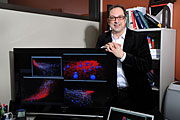- Number 335 |
- April 18, 2011
Neural networks make intelligent sensors, smarter smart grids

Neural networks, combined
with "fuzzy math" are used
to build data-driven maps
of data that group
information in clusters which
researchers can evaluate.
Milos Manic, a University of Idaho professor and Center for Advanced Energy Studies (CAES) researcher, specializes in neural networks — algorithms that help computers learn by mimicking human intelligence and reasoning. CAES is a research partnership between DOE's Idaho National Laboratory, Boise State University, Idaho State University and University of Idaho.
Manic's research focuses primarily on creating neural networks and combining them with "fuzzy math" to build data-driven models such as self-organizing maps of data. The maps examine data for similarities and interdependencies then group them in clusters, which researchers can evaluate. The maps are loaded into a computer-assisted virtual environment — or CAVE —so researchers can view the data in 3-D.
"It is difficult for humans to view and analyze 12 to 15 sets of data and group them," Manic said. "We're just not set up for it. With self-organizing maps, a computer is able to organize and visualize it for us. It can help researchers find correlations they might not have been able to otherwise see."
One research project involves smart cyber sensors that provide situational awareness in industrial control or smart grid systems. The use of neural networks and fuzzy math helps sensors collect and fuse different types of data, analyze different factors and predict future behavior of the system. This could improve on traditional sensors, which simply detect signals, but do not perform intelligent analysis on their own.
[Kortny Rolston, 208.526.0962,
kortny.rolston@inl.gov]
